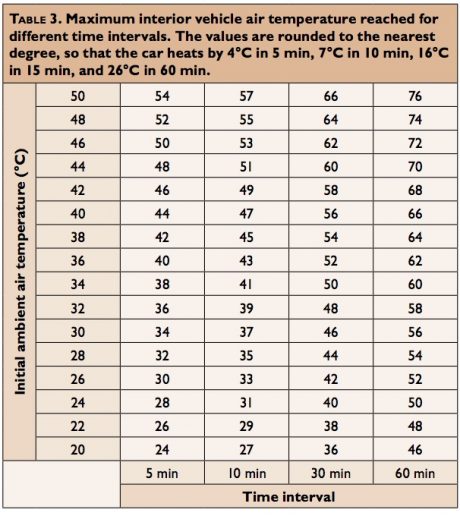Two tragedies last week were reminders of a continuing and underrated weather hazard: people continue to leave children in their parked automobiles, where the heat is ever escalating. The victims in the separate incidents in Oregon and California on June 20 and 21 were both under two years of age.
An average of 37 children each year die from hyperthermia while left alone in automobiles, largely due to persisting misconceptions about the heat dangers of the interior of a car.
For many years now, Jan Null, an AMS Certified Consulting Meteorologist in northern California, has been fighting these misconceptions about the heat danger of leaving children in cars. In addition to his studies, presented at AMS conferences (e.g., watch one here), Null operates a web site of statistics on child hyperthermia in cars.
Perhaps the first big misconception Null refuted is that conditions outside need to be blisteringly hot. Ordinary warm days are dangerous, too. The outdoor temperatures in last week’s deaths were 80°F and 81°F.
This point has been thoroughly documented in studies by Null as well as others, and was reviewed and refined in a paper in the Bulletin of the American Meteorological Society, by Andrew Grundstein, John Down, and Vernon Meentemeyer.
These studies show that temperatures climb surprisingly fast in the car’s interior. Here’s a table from Grundstein et al.:

It’s also a misconception to think that adults are a good judge of what conditions are tolerable. Null reminds people that children are physically much more responsive to conditions—they heat up two or three times faster than adults.
Because leaving children unattended in cars is illegal in some states, one might think these deaths are a case of bad parents making bad decisions. Yet less than one in five of these hyperthermia deaths is because a parent intentionally left the child in the car to, say, run errands. Null’s statistics show that about 400 (54%) of the 760+ heat stroke deaths since 1998 occur when caregivers forget a child is in the car. Almost 30% of the deaths occur when children climb unattended into the cars by themselves and get locked in.
But perhaps the most insidious misconception is that unfit—or forgetful or distracted or hurried or overworked—parents are the most susceptible to being forgetful about such an important matter.
In an AMS presentation, the University of Georgia’s Castle Williams revealed the perceptions that lead to such mental mistakes. Many parents and caregivers don’t believe that they are capable of leaving a child in a car by mistake. As a result, these parents considered it very unlikely that their child might suffer hyperthermia in a car, even as they recognized that the consequences would be severe. They believed that certain demographics–poor, single, working parents–would be more prone to such mistakes. This mismatch in perception of risk and awareness of consequences creates a communication challenge.
“All parents are at risk for this issue. It can happen to anyone,” Williams noted. (The results from his interviews with parents were later published in the the journal, Injury Prevention). “None of the demographic variables show any kind of relationship of having an increased risk of this occurring.”
How to combat the deadly misconceptions about kids in hot cars? According to Williams, “New messaging should focus on increasing perceived susceptibility to emphasize that every parent and caregiver is equally susceptible to forgetting their child in a hot car.”
Organizations such as Safe Kids Worldwide have begun stepping up efforts to inform people of the risks. And Williams’s study shows parents are paying attention to news reports of incidents on TV and in social media. Perhaps the misconceptions can be dispelled soon.
1 thought on “Kids in Hot Cars: Tragic Misconceptions”
Comments are closed.
Tragically this happens all over the world. I am posting it in my FB profile.